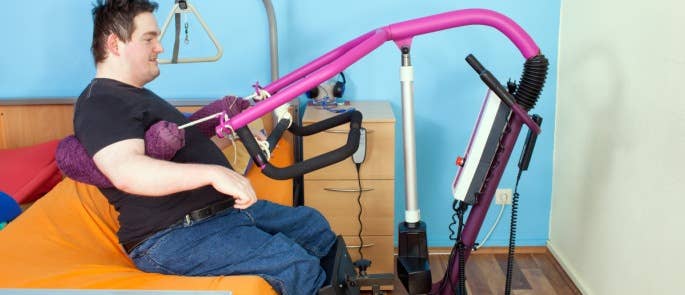
Those working in health and social care have the right to work in a safe and healthy environment and service users should be provided with person-centred safe care that respects their rights, freedoms and dignity. It is an integral part of a care worker’s duty of care to work in a safe and competent manner without risking harm to those they care for.
Health and safety is about identifying risks and the ways they are managed, controlled and prevented. Within a care home setting there are many potential health and safety challenges that need to be highlighted and assessed to enable them to be managed effectively.
This article details the most common safety hazards found within care homes, outlines how risks can be managed, explains responsibilities for ensuring service users’ safety and looks at the key legislation to be aware of.

A hazard is defined as a potential source of harm and you only have to picture a busy care home to see its potential for health and safety hazards. They are home to multiple occupants, many of which are vulnerable due to their age, health conditions or mobility, as well as being busy with staff, family and other professional bodies who may be present.
Care home activities often involve the moving and handling of people, equipment and stock along with personal care tasks, medication administration, cleaning, cooking and many more. Everyone within the care home can be at risk of encountering potential hazards. Some of the key areas where hazards are often present are:

Health and social care workers must only perform duties once they are deemed fully trained and competent to do so. They have a responsibility to work in line with the legislation, policies and procedures in place for each task they undertake. They are responsible for taking reasonable care of themselves and all those within the workplace.
There are many legal responsibilities for the employer. Management must ensure that there are robust systems in place to assess whether these responsibilities are being met and record and review them. They must support the protection of their employees’ and service users’ health and safety and their general wellbeing. They are responsible for providing a safe working environment, appropriate training and safe working equipment.
Health and safety in the workplace must be everyone’s responsibility. Everyone must act in a way to avoid causing harm to any person or property and it is everyone’s duty to report potential hazards when they see them. Health and safety legislation exists within a care home to protect people at work, those who are affected by working activities and those receiving care and support.
![]()
If you want to learn more about key areas of health and safety in a care setting, why not check out our Fire Safety for Care Homes or Moving and Handling of People in Residential Care courses? Furthering your knowledge is a great way to improve your professional development and helps you provide safer, higher quality care.
Acts, regulations and orders set out the requirements that each care home’s policies and procedures must meet. Some of the key pieces of legislation for health and safety in care are:

We have discussed the responsibility of management and care workers in relation to health and safety. It is important to remember that managing the associated risks needs the cooperation of everyone at all levels. There are always practical steps to take during day-to-day duties, such as:
One of the most important ways a care worker can minimise any risks to themselves or service users is to work in line with current legislation and the organisation’s policies and procedures. They should also only perform tasks when they are fully trained and competent.
Risk assessments in care homes play an important role in maintaining health and safety standards and are required to identify the vast range of hazards that can be present. When creating policies and procedures that mitigate and manage these risks, it is worth considering what needs to be achieved to meet the expected standards of the regulator during a health and safety audit.

Along with all other relevant legislation and HSE guidance, the Care Quality Commission (CQC) requires care homes to operate in line with the Health and Social Care Act 2008 (Regulated Activities) Regulations 2014: Regulation 12. This is intended to prevent those receiving care and treatment from any avoidable harm or risk of harm through unsafe care. It states that providers must assess risks to a person’s health and safety during care and treatment and that staff must have the competences, training and skills to keep people safe.
Under this regulation, both premises and equipment must be safe and available in sufficient quantities where needed. Medications must also be supplied in sufficient quantities and safely managed and administered.
The spread of infection must be prevented and controlled and when the responsibility for a service user’s care and treatment is shared, timely planning of care is required to maintain health, safety and welfare.
The care home must demonstrate they have taken all reasonable steps to ensure the health and safety of their service users and to manage any risks that may arise during care and treatment.
The CQC can prosecute for a breach of part or all of the regulation if it results in avoidable harm or exposure to significant risk of harm by a service user. The CQC must refuse registration if it cannot be shown satisfactorily that the provider will continue to comply with this regulation.

We have discussed within this article that many hazards present themselves within a care home setting and that these hazards must be managed, controlled and prevented. Here, we provide a health and safety audit template that helps to consolidate all the areas that must be checked and policies that must be in place. This should make it easier to ensure health and safety processes are in place effectively throughout the home.
It is recommended you print out this audit template so it can be completed and accessible for staff to utilise. This is not an exhaustive list so there are additional blank spaces for you to add more information that you may find appropriate within your organisation.
Health and safety in care homes is about identifying risks and how they are managed, controlled and prevented. It is every member of staff’s duty of care to protect themselves and those around them from harm. All care homes must have robust systemic processes in place to protect the health and safety of their workers and service users at all times.